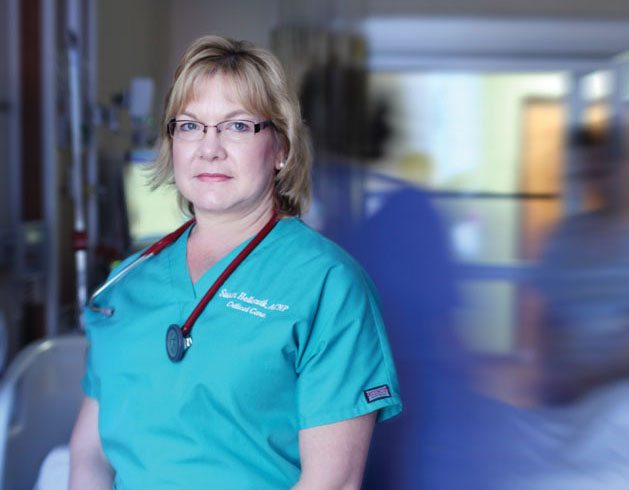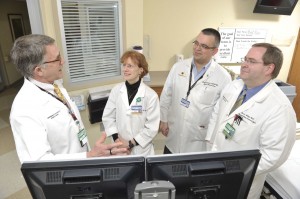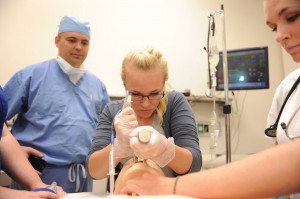
Minutes from now, the newly conscious patient will flail softly in her bed and try to pull out her breathing tube. A nurse will be there to stay her hand. Right now, though, she’s slipping toward death. As she was being turned in her bed, her heart rate plummeted, and it hasn’t returned. She’s gone rigid and lifeless.
It’s mid-morning in the Medical Intensive Care Unit at Vanderbilt University Hospital. A code is called, and doctors, nurses and nurse practitioners come rushing down wide hallways.
health care providers are swarming the bedside. A critical care medicine fellow has planted himself at the foot of the bed to direct the code. The activity is intense but everyone appears calm.
The patient’s mother, walking with a cane, is helped out of the room by a young family member, and as they thread their way, the younger woman uses a hand to shield the old woman’s eyes from the scene at the bedside.
In the thick of the activity is the patient’s frontline provider, intensivist nurse practitioner Susan Hellervik, ACNP-BC (VUSN ‘09). In spring of 2009 she was among the inaugural graduates of VUSN’s new intensivist track for acute care nurse practitioners. Prompted by new resident work-hour restrictions, VUH and hospitals across the country are increasingly turning to ACNPs as intensive care providers. Two-thirds of Vanderbilt’s MICU patients are managed by resident physicians, but the rest, including this patient, are managed by intensivist ACNPs.
The patient receives rapid chest compressions for artificial circulation. To help restore a viable heart rate, she gets an emergency injection of epinephrine.
Life measurably returns. Those jolting paired electric paddles familiar from TV shows never appear. Within minutes, most of the responders have peeled away.
“We train nurse practitioners so they can help people on the worst day of their lives,” said Josh Squiers, MSN, ACNP, program coordinator for the School of Nursing’s ACNP intensivist track.
There’s new demand for, and a deep shortage of, intensive care specialists in the U.S. ACNPs by now are welcomed with open arms as intensivists by critical care medicine. However, hospitals have found it takes 12 to 18 months of training to turn a typical ACNP graduate into a fully functioning and adequately autonomous member of an intensive care team.
C. Lee Parmley, MD, JD, lobbied for an intensivist track at VUSN. He’s professor of Anesthesiology and executive medical director of critical care at Vanderbilt. “We traditionally operated with interns, residents and fellows, but new work-hour restrictions for those trainees have gutted that staffing,” he said.
That’s not to say that intensivist ACNPs are simply an alternative staffing solution. They have their own role to play in a model of care that’s becoming ever more team-based. According to Parmley, with more intensivist ACNPs at work at VUMC, “there’s a more consistent level of care throughout the month, care is more standardized, and it’s better from a patient safety standpoint.”
The intensivist ACNPs are pleased to be working at the top of their license, with the full support of attendings, unit medical directors and the hospital. They manage Vanderbilt’s sickest patients in close collaboration with fellows (physicians in transition from residency to independent practice) and attending physicians. “We help physicians, so they can see more patients and we can assist managing details,” said Teresa Simpson, ACNP-BC (VUSN ‘09), who works in the Cardiovascular ICU. “We’re responsible for the multi-disciplinary approach, monitoring everything from bowel movements to discharge planning. I’m supposed to know the patient better than anyone.”
In the past two years VUH has doubled its complement of ACNPs. According to April Kapu, ACNP-BC, assistant director of Advanced Practice Critical Care for VUH, the hiring was precipitated by the new resident work-hour restrictions and with the opening of a new VUH critical care tower, which doubles the number of critical care beds.
“Beyond filling that potential gap in coverage, beyond helping decrease length of stay and being productive from a revenue standpoint, intensivist ACNPs are providing the continuity and consistency we need to help ensure the quality of our care,” Kapu said.
Intensivist ACNPs at VUH order and interpret labs, order medication, write progress notes and perform routine invasive procedures. On some units they work beside residents and interns, and on others — including the CVICU, the MICU and soon the surgical ICU — they form their own service, working independently of house staff. They have faculty appointments in the School of Medicine and receive administrative and practice oversight from VUH Nursing. Their work is billed through Vanderbilt Medical Group. They cover most Vanderbilt ICUs 24 hours a day, seven days a week. Many of the ACNPs are credentialed to perform bronchoscopies, place central lines and intubate.
They meet with family members and gather consent for treatment, and they arrange consults with specialists of all stripes.
This year, 12 of the 72 ACNP students at VUSN have chosen the intensivist subspecialty track.

“We use different clinical rotations and an emphasis on intensive simulations, so that our students are prepared to join intensivist teams straight from graduation,” said professor and ACNP Program Director Joan King, PhD, ACNP-BC, ANP-BC, FAANP. She and colleagues piloted the track in the fall of 2008, and soon after won a three-year, $872,000 supporting grant from the Health Resources and Services Administration. The track benefits from ongoing partnerships with critical care faculty in the School of Medicine, and makes extensive use of patient care simulation capabilities at the Vanderbilt Center for Experiential Learning.
Graduates of the track are recruited by top flight hospitals. For employers, these ACNPs represent a unique skill set, reduced orientation requirements and better patient outcomes.
“We’ve emphasized fast decision-making and the team dynamics found in the ICU. Patients today are sicker, technology is more complex, and the payment model is changing. If you can be faster and improve outcomes, it makes a big difference. There’s an increasing reliance on teamwork, and employers will find that our graduates are much more prepared for integration with the intensivist team,” King said.
Many of the graduates happen to be former ICU staff nurses. Maria Troche, ACNP-BC (VUSN ‘11) completed orientation in the VUH Burn Center in November.
“I’ve been in codes up here, and without the [intensivist track’s] extra clinical hours and simulations, I don’t think I could have reacted as well as I did,” she said.
Mindy French, ACNP-BC (VUSN ‘10), works on the SICU.
“Doing the ICU rotations and the simulations makes you more comfortable and confident to do procedures and run codes. The simulations were amazingly beneficial,” she said.
White wavy lines snake across a black background: in the CVICU, a bank of monitors at the nurses’ station displays the electrical readout from each patient’s heart. During morning rounds, that includes Teresa Simpson, a heart transplant surgeon, a heart failure specialist, a critical care medicine specialist, a critical care medicine fellow and a staff nurse stands in the hallway talking in a circle. In a nearby room a semi-conscious end-stage heart-failure patient awaits a donor heart. He’s on a ventilator. His blood continues to flow thanks to two ventricular assist devices, which form a piece of bedside machinery the size of a steamer trunk. With kidneys failing, he’s on dialysis as well.

To an outsider, the discussion in the hallway is opaque. But a few things are clear. The patient’s spiking white blood cell count presents some added concern, because if outright systemic infection were to develop it would bump the patient from his place atop the heart recipient list.
“In this job, you get to see patients turn around from that to talking,” Simpson said, sitting at her workstation. She’s examining routine X-rays, checking lungs for something called overload and making sure chest tubes and catheters are in correct position. Many patients spend only a day on the unit, but other cases are far less straightforward.
“At Vanderbilt we take on the sickest of the sick, so we have quite a large population that needs finessing,” she said.
Simpson recalls the switch to intensivist ACNP as a stark change from her former staff nursing days. “You move into a different role of autonomy. I remember thinking, now it’s me giving that order.’
If it doesn’t work out right it comes back to me.”
The previous day, Simpson’s work had put her in the middle of a discussion between a cardiac surgeon who wanted to proceed with a treatment and a nephrology consultant who wanted to wait.
Taped to the wall in the workroom that Simpson shares with fellows and intensivist ACNPs is a cartoon drawing of a fish eyeing a worm on a hook. The caption reads, “Don’t be baited.” Its inside meaning for the people in the workroom is, don’t be baited into open conflict for no good reason.
“A lot of this job is conflict – dealing with conflict, heading off conflict. Sometimes you just have to be more assertive,” she said.

Intensivist ACNPs in Vanderbilt’s MICU and SICU respond to cardiac/respiratory arrest codes on their own and other units, and they staff a consultation service called the Rapid Response Team, for patients anywhere in the hospital who, though not yet coding, appear potentially headed for danger.
When the code was running on her patient that morning in the MICU, Hellervik was asking herself lots of questions.
“I was asking myself, ‘what’s the most quickly reversible thing that may have caused this? ‘Was the patient’s ventilation adequate, for example?’ And while I was sequencing through those potential causes, I was checking to see that she was receiving good chest compression and that all other aspects of advanced cardiac life support were being implemented correctly,” she said.
The fast pace and criticality of intensive care decision-making is apparently a big part of the job appeal. As Maria Troche put it, “The ICU is just fun, it’s an adrenaline rush. I just like the intensity. There’s always something complex, something challenging.”
“I like the fast pace, thinking on your feet,” Simpson said.
Mindy French put it most simply: “I like the sick people.”
When it comes to protocol, when it comes to routine specialized management, intensivist ACNPs can’t help but be more studied and experienced than their resident counterparts on rotation in the ICU. Under health care reform, pressure to improve quality and reduce length of stay will only increase, making intensivist ACNPs that much more highly sought. Vanderbilt plans to hire more intensivist ACNPs as the units expand and patient acuity rises.